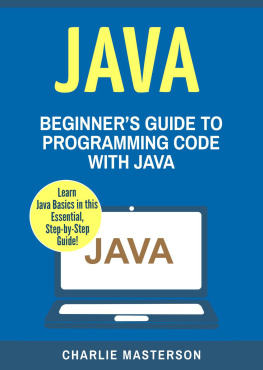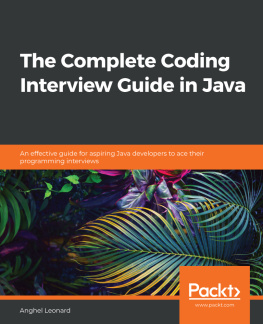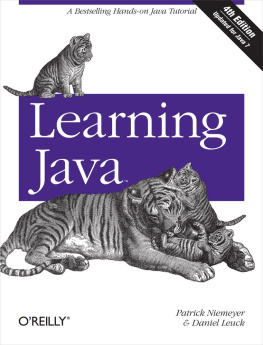Languages - Learning Java Coding Language: Complete tutorial
Here you can read online Languages - Learning Java Coding Language: Complete tutorial full text of the book (entire story) in english for free. Download pdf and epub, get meaning, cover and reviews about this ebook. year: 2020, publisher: Unknown, genre: Computer. Description of the work, (preface) as well as reviews are available. Best literature library LitArk.com created for fans of good reading and offers a wide selection of genres:
Romance novel
Science fiction
Adventure
Detective
Science
History
Home and family
Prose
Art
Politics
Computer
Non-fiction
Religion
Business
Children
Humor
Choose a favorite category and find really read worthwhile books. Enjoy immersion in the world of imagination, feel the emotions of the characters or learn something new for yourself, make an fascinating discovery.

- Book:Learning Java Coding Language: Complete tutorial
- Author:
- Publisher:Unknown
- Genre:
- Year:2020
- Rating:3 / 5
- Favourites:Add to favourites
- Your mark:
- 60
- 1
- 2
- 3
- 4
- 5
Learning Java Coding Language: Complete tutorial: summary, description and annotation
We offer to read an annotation, description, summary or preface (depends on what the author of the book "Learning Java Coding Language: Complete tutorial" wrote himself). If you haven't found the necessary information about the book — write in the comments, we will try to find it.
Languages: author's other books
Who wrote Learning Java Coding Language: Complete tutorial? Find out the surname, the name of the author of the book and a list of all author's works by series.
Learning Java Coding Language: Complete tutorial — read online for free the complete book (whole text) full work
Below is the text of the book, divided by pages. System saving the place of the last page read, allows you to conveniently read the book "Learning Java Coding Language: Complete tutorial" online for free, without having to search again every time where you left off. Put a bookmark, and you can go to the page where you finished reading at any time.
Font size:
Interval:
Bookmark:
Chapter 1: Getting started with Java Language 2
Remarks 2 Java Editions and Versions 2
Compiling and running Java programs 3
What's next? 3
Examples 4
Creating Your First Java Program 4 A closer look at the Hello World program 6
Chapter 2: 2D Graphics in Java 11
Introduction 11
Examples 11
Example 1: Draw and Fill a Rectangle Using Java 11
Example 2: Drawing and Filling Oval 13 Chapter 3: Alternative Collections 14
Remarks 14
Examples 14
Apache HashBag, Guava HashMultiset and Eclipse HashBag 14
1. Using SynchronizedSortedBag from Apache: 14
2. Using TreeBag from Eclipse(GC): 15
3. Using LinkedHashMultiset from Guava: 15
Multimap in Guava, Apache and Eclipse Collections 16 Nore examples: 19
Compare operation with collections - Create collections 19
Compare operation with collections - Create collections 19
Chapter 4: Annotations 25
Introduction 25
Syntax 25
Examples 25
Runtime annotation checks via reflection 29
Defining annotation types 29
Meta-Annotations 30
Available Values 30
@Retention 31
Available values 32
@Repeatable 32
Getting Annotation values at run-time 32
Repeating Annotations 33
Inherited Annotations 35
Example 35
Compile time processing using annotation processor 36 The annotation 36
The annotation processor 36
Packaging 38
Example annotated class 38
Using the annotation processor with javac 38
IDE integration 39
Netbeans 39
Result 39
The idea behind Annotations 40
Annotations for 'this' and receiver parameters 40
Add multiple annotation values 41 Chapter 5: Apache Commons Lang 42
Examples 42
Implement equals() method 42
Implement hashCode() method 42
Chapter 6: AppDynamics and TIBCO BusinessWorks Instrumentation for Easy Integration 45
Introduction 45
Example of Instrumentation of all BW Applications in a Single Step for Appdynamics 45 *** Common variables. Modify these only. *** 45
Chapter 7: Applets 47
Introduction 47
Remarks 47
Examples 47
Minimal Applet 47
Creating a GUI 48
Open links from within the applet 49
Loading images, audio and other resources 49
Load and show an image 49
Load and play an audio file 50
Load and display a text file 50 Chapter 8: Arrays 52
Introduction 52
Syntax 52
Parameters 52
Examples 52
Basic cases 52
Arrays, Collections, and Streams 53
Creating and initializing primitive type arrays 55
Creating and initializing multi-dimensional arrays 56
Multidimensional array representation in Java 57
Creating and initializing reference type arrays 57
Creating and initializing generic type arrays 58
Filling an array after initialization 58
Separate declaration and initialization of arrays 59
Arrays may not be re-initialized with array initializer shortcut syntax 59
Creating an Array from a Collection 60
Arrays to a String 61
Creating a List from an Array 62
Important notes related to using Arrays.asList() method 63
Multidimensional and Jagged Arrays 64 How Multidimensional Arrays are represented in Java 65
ArrayIndexOutOfBoundsException 66
Getting the Length of an Array 67
Comparing arrays for equality 67
Arrays to Stream 68
Iterating over arrays 68
Copying arrays 71 for loop 71
Object.clone() 71
Arrays.copyOf() 72
System.arraycopy() 72
Arrays.copyOfRange() 72 Casting Arrays 73
Remove an element from an array 73
Using ArrayList 73 Using System.arraycopy 74
Using Apache Commons Lang 74
Array Covariance 74
How do you change the size of an array? 75 A better alternatives to array resizing 76
Finding an element in an array 76 Using Arrays.binarySearch (for sorted arrays only) 76
Using a Arrays.asList (for non-primitive arrays only) 76
Using a Stream 77
Linear search using a loop 77
Linear search using 3rd-party libraries such as org.apache.commons 77
Testing if an array contains an element 77
Sorting arrays 78
Converting arrays between primitives and boxed types 79 Chapter 9: Asserting 81
Syntax 81
Parameters 81
Remarks 81
Examples 81
Checking arithmetic with assert 81 Chapter 10: Atomic Types 82
Introduction 82
Parameters 82
Remarks 82
Examples 82
Creating Atomic Types 82
Motivation for Atomic Types 83 How does one implement Atomic Types? 84
How do Atomic Types work? 85 Chapter 11: Audio 87
Remarks 87 Examples 87
Play an Audio file Looped 87
Play a MIDI file 87
Bare metal sound 89
Chapter 12: Autoboxing 91
Introduction 91
Examples 91
Using int and Integer interchangeably 91
Using Boolean in if statement 92
Auto-unboxing may lead to NullPointerException 93
Memory and Computational Overhead of Autoboxing 93
Different Cases When Integer and int can be used interchangeably 94 Chapter 13: Basic Control Structures 96
Remarks 96
Examples 96
If / Else If / Else Control 96
For Loops 97
While Loops 98
do...while Loop 98
For Each 98
If / Else 99
Switch statement 100
Ternary Operator 102
Try ... Catch ... Finally 102
Nested break / continue 103
Chapter 14: Benchmarks 105
Introduction 105
Simple JMH example 105 Chapter 15: BigDecimal 108
Introduction 108
Examples 108
BigDecimal objects are immutable 108
Comparing BigDecimals 108
Mathematical operations with BigDecimal 108 1.Addition 108
2.Subtraction 109
3.Multiplication 109
4.Division 109
5.Remainder or Modulus 110
6.Power 110
7.Max 111
8.Min 111
9.Move Point To Left 111
10.Move Point To Right 111
Using BigDecimal instead of float 112
BigDecimal.valueOf() 113
Initialization of BigDecimals with value zero, one or ten 113 Chapter 16: BigInteger 114
Introduction 114
Syntax 114
Remarks 114
Examples 115
Initialization 115
Comparing BigIntegers 116
BigInteger Mathematical Operations Examples 117
Binary Logic Operations on BigInteger 119
Generating random BigIntegers 120 Chapter 17: Bit Manipulation 122
Remarks 122
Examples 122
Packing / unpacking values as bit fragments 122
Checking, setting, clearing, and toggling individual bits. Using long as bit mask 123
Expressing the power of 2 123
Checking if a number is a power of 2 124
java.util.BitSet class 126
Signed vs unsigned shift 126 Chapter 18: BufferedWriter 128
Syntax 128
Remarks 128
Examples 128
Write a line of text to File 128 Chapter 19: ByteBuffer 130
Introduction 130
Syntax 130
Examples 130
Basic Usage - Creating a ByteBuffer 130
Basic Usage - Write Data to the Buffer 131
Basic Usage - Using DirectByteBuffer 131 Chapter 20: Bytecode Modification 133
Examples 133
What is Bytecode? 133 What's the logic behind this? 133
Well, there has to be more right? 133
How can I write / edit bytecode? 133
I'd like to learn more about bytecode! 134
How to edit jar files with ASM 134
How to load a ClassNode as a Class 137
How to rename classes in a jar file 137
Javassist Basic 138
Chapter 21: C++ Comparison 140
Introduction 140
Remarks 140 Classes Defined within Other Constructs# 140
Defined within Another Class 140
C++ 140
Java 140 Statically Defined within Another Class 140
C++ 140
Java 141 Defined within a Method 141
C++ 141
Java 141 Overriding vs Overloading 141
Order of Construction/Destruction 142
Object Cleanup 142
Abstract Methods & Classes 143
Accessibility Modifiers 143
C++ Friend Example 143 The Dreaded Diamond Problem 144
java.lang.Object Class 144
Java Collections & C++ Containers 144
Font size:
Interval:
Bookmark:
Similar books «Learning Java Coding Language: Complete tutorial»
Look at similar books to Learning Java Coding Language: Complete tutorial. We have selected literature similar in name and meaning in the hope of providing readers with more options to find new, interesting, not yet read works.
Discussion, reviews of the book Learning Java Coding Language: Complete tutorial and just readers' own opinions. Leave your comments, write what you think about the work, its meaning or the main characters. Specify what exactly you liked and what you didn't like, and why you think so.






